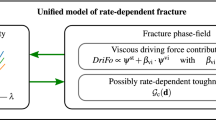Abstract
Elastomeric materials show a wide range of different elastic and inelastic properties. Additionally, this class of materials is subjected to large deformations. Considering all these effects, fracture mechanical investigations are very challenging tasks and cannot be performed with standard approaches. Effects of inhomogeneities and discontinuities such as cracks can be investigated with the so-called material force approach in an efficient and elegant way. For comprehensive investigations of inelastic materials, the complete balance of the material motion problem has to be formulated. In this case, the material volume forces depend on the internal history variables which are required for the inelastic constitutive model. This paper derives a general formulation for rate-dependent and rate-independent inelastic materials based on a multiplicative split of the deformation gradient to cover viscoelastic and elastoplastic materials at finite deformations.
Similar content being viewed by others
References
Braun M (1997) Configurational forces induced by finite- discretization. In: Proceedings of the estonian academy of sciences, physics, mathematics, vol 46, pp 24–31
Eshelby JD (1951) The force on an elastic singularity. Philos Trans R Soc Lond Ser A Math Phys Sci 244:87–112
Eshelby JD (1975) The elastic energy-momentum tensor. J Elast 5:321–335
Gross D, Kolling S, Müller R, Schmidt I (2003) Configurational forces and their application in solid mechanics. Eur J Mech A/Solids 22:669–692
Gurtin ME (2000) Configurational forces as basic concepts of continuum Physics. Springer, Heidelberg
Kaliske M, Rothert H (1998) Constitutive approach to rate-independent properties of filled elastomers. Int J Solids Struct 35:2057–2071
Kaliske M, Näser B, Müller R (2005) Formulation and computation of fracture sensitivity for elastomers. In: Austrell PE, Kari L (eds) Constitutive models for rubber IV. A. A. Balkema Publishers, pp 37–43
Kienzler R, Herrmann G (2000) Mechanics in material space. Springer, Heidelberg
Kolling S (2001) Zur numerischen Simulation von Morphologieänderungen in mikroheterogenen Materialien. PhD thesis, Institut für Mechanik, TU Darmstadt
Lee EH (1969) Elastic-plastic deformation at finite strains. ASME. J Appl Mech 36:1–6
Liebe T, Denzer R, Steinmann P (2003) Application of material force method to isotropic continuum damage. Comput Mech 30:171–184
Maugin GA (1993) Material inhomogeneities in elasticity. Chapman & Hall, London
Menzel A, Denzer R, Steinmann P (2004) On the comparision of two approaches to compute material forces for inelastic materials. Application to single-slip crystal-plasticity. Comput Methods Appl Mech Eng 193:5411–5428
Miehe C (1993) Kanonische Modelle Multiplikativer Elasto-Plastizität. Thermodynamische Formulierung und numerische Implementation. Habilitationsschrift, Institut für Baumechanik und Numerische Mechanik, Universität Hannover
Müller R (2001) 3D-Simulation der Mikrostrukturentwicklung in Zwei-Phasen-Materialien. PhD thesis, Institut für Mechanik, TU Darmstadt
Müller R, Maugin GA (2002) On material forces and finite element discretizations. Comput Mech 29:52–60
Müller R, Kolling S, Gross D (2002) On configurational forces in the context of finite element method. Int J Numer Methods Eng 53:1557–1574
Näser B, Kaliske M (2003) Numerische bruchmechanische Analysen mittels materieller Kräfte. Leipzig Ann Civil Eng Report 8:265–280
Nguyen TD, Govindjee S, Klein PA, Gao H (2005) A material force method for inelastic fracture mechanics. J Mecha Phys Solids 53:91–121
Rice JR (1968) A path independent integral and the approximate analysis of strain concentration by notches and cracks. J Appl Mech 35:379–386
Steinmann P (2000) Application of material force to hyperelastostatic fracture mechanics. I. Continuum mechanical setting. Int J Solids Struct 37:7371–7391
Steinmann P, Ackermann D, Barth FJ (2001) Application of material force to hyperelastostatic fracture mechanics. II. Computational setting. Int J Solids Struct 38:5509–5526
Zimmermann D, Miehe C (2004) Material forces in standard dissipative solids obtained from an incremental variational formulation. In: Proceedings in applied mathematics and mechanics, Wiley-VCH, vol 4, pp 274–275
Author information
Authors and Affiliations
Corresponding author
Rights and permissions
About this article
Cite this article
Näser, B., Kaliske, M. & Müller, R. Material forces for inelastic models at large strains: application to fracture mechanics. Comput Mech 40, 1005–1013 (2007). https://doi.org/10.1007/s00466-007-0159-9
Received:
Accepted:
Published:
Issue Date:
DOI: https://doi.org/10.1007/s00466-007-0159-9




